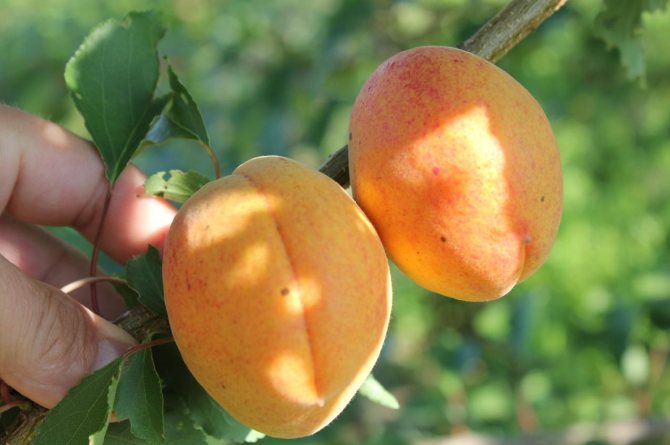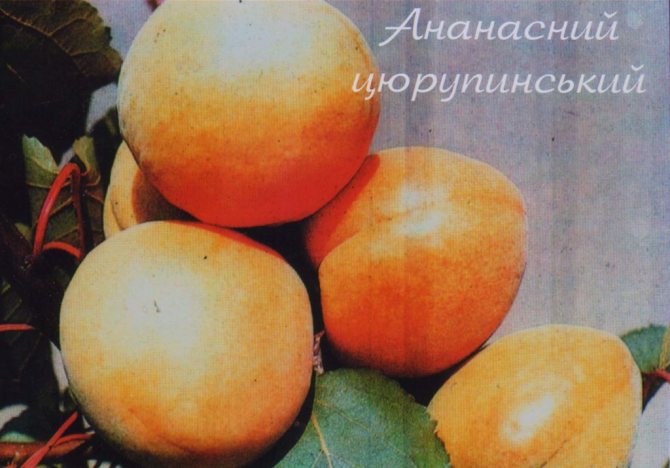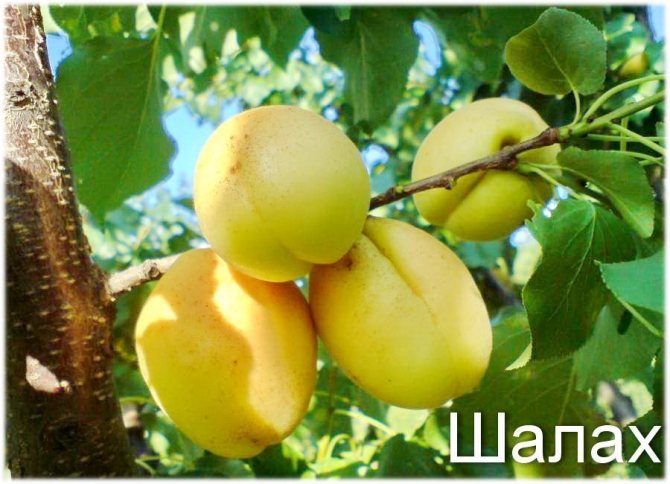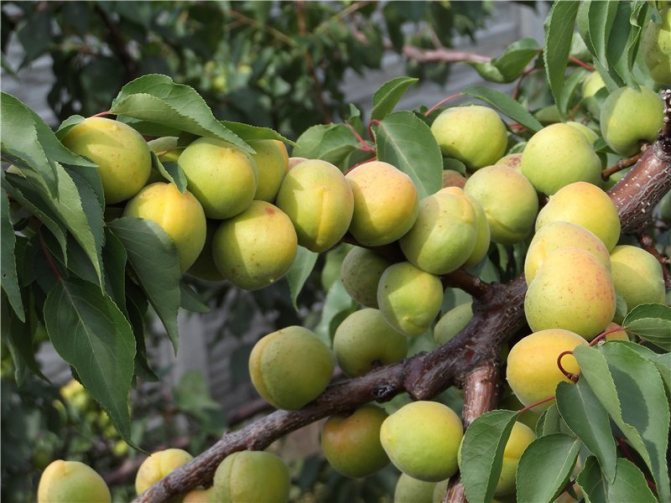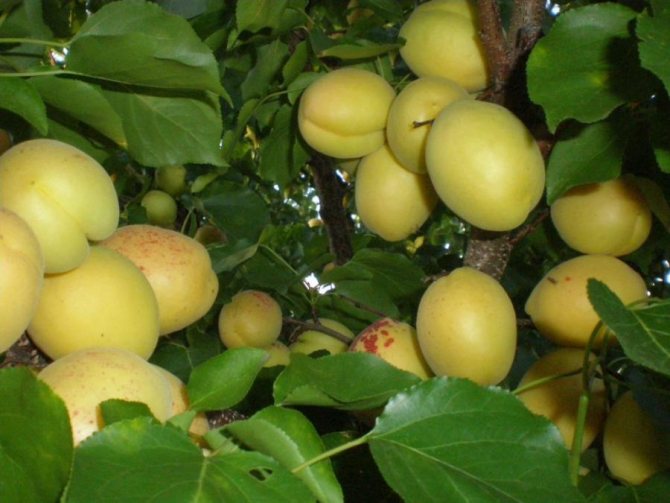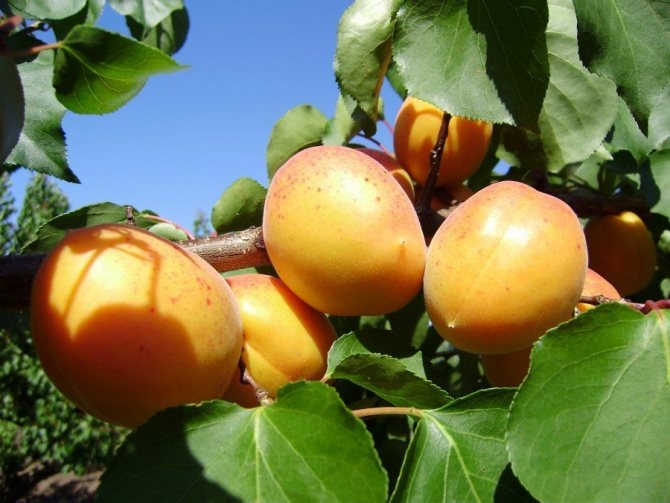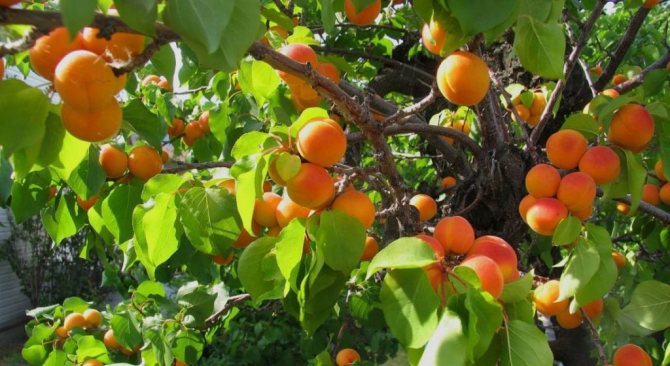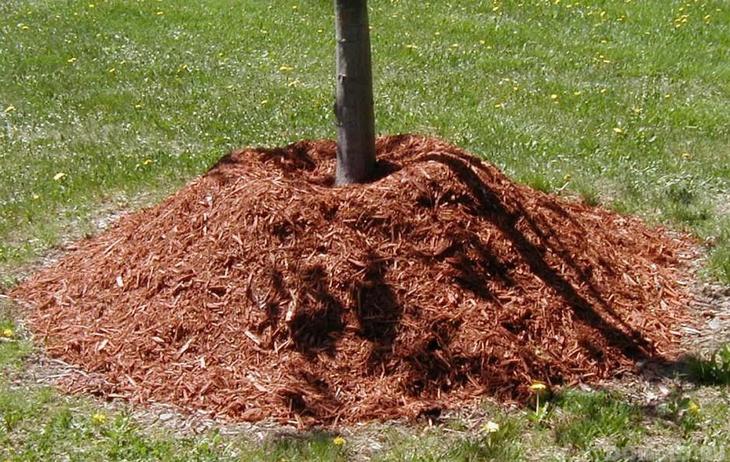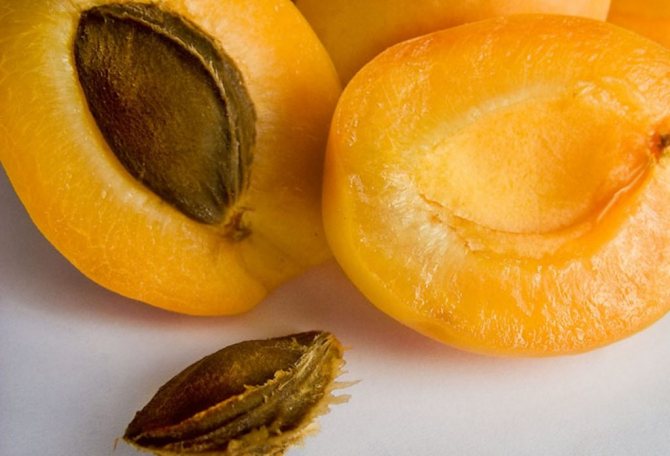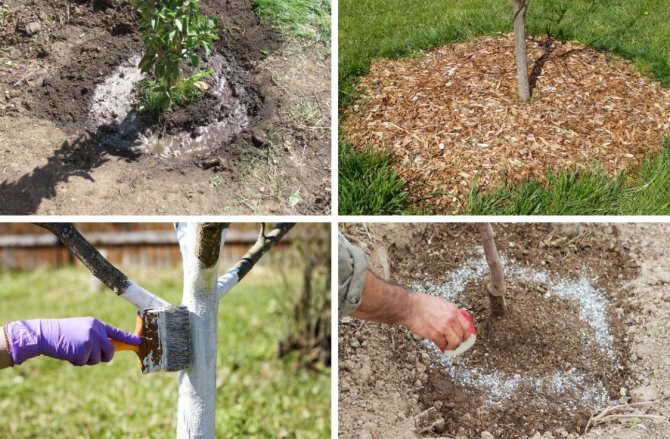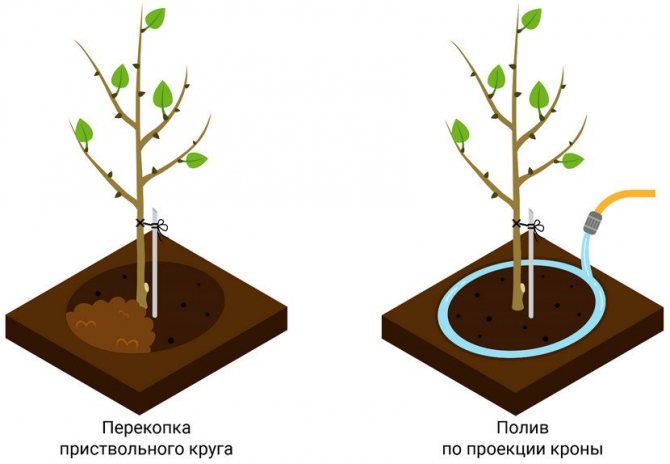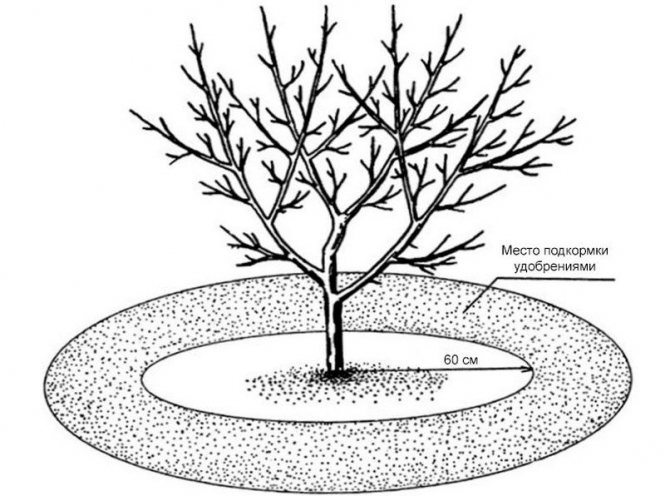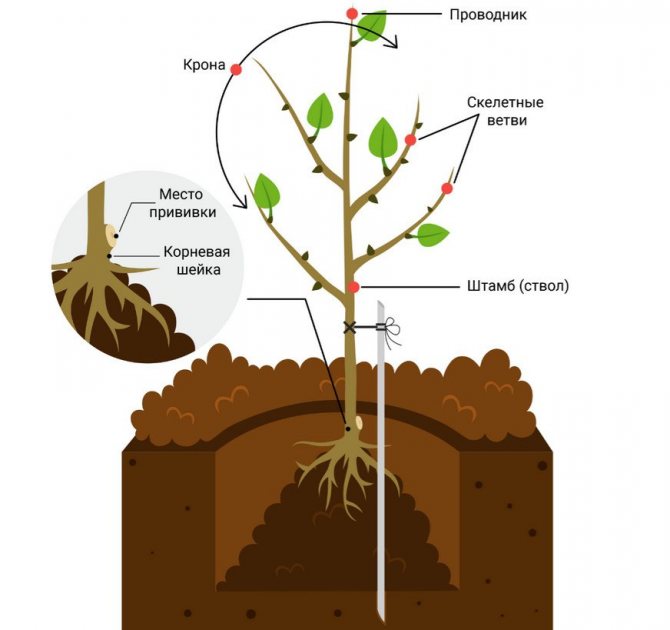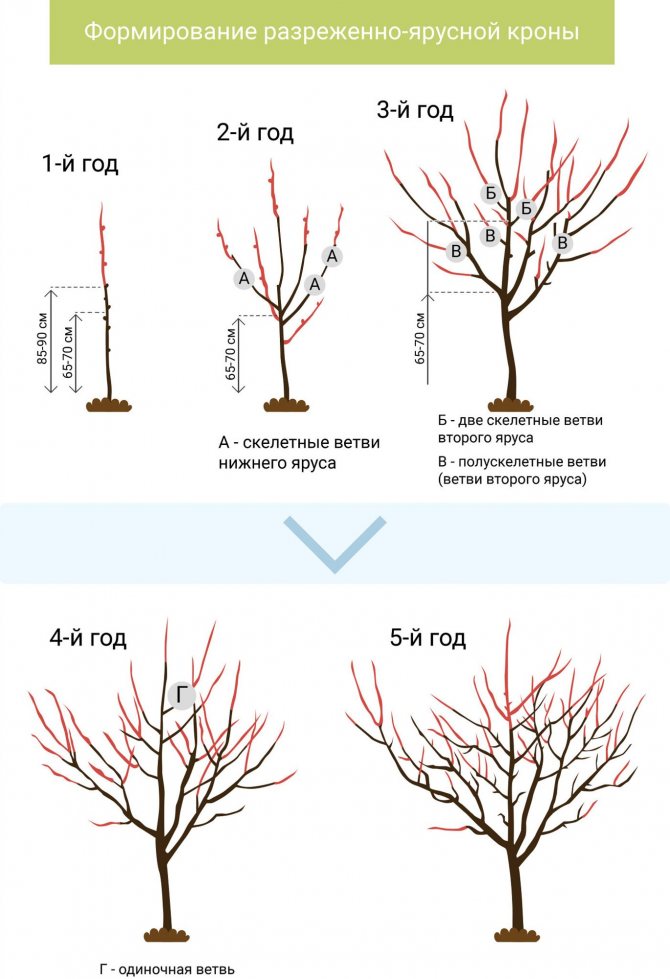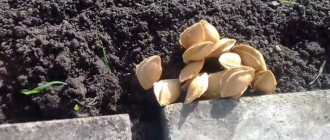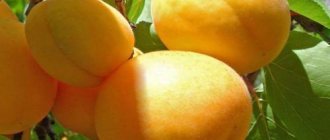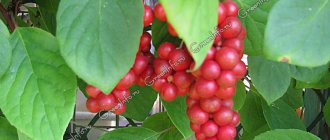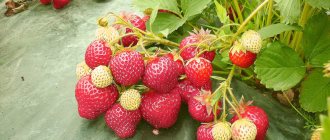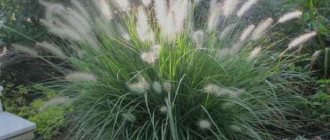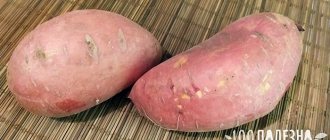Description of the white apricot variety Pineapple
There are many types of apricots, but Pineapple (Shalakh), an ancient variety that appeared in Armenia, most likely from a successful seedling, is not inferior to its position. After all, folk selection was aimed at selecting specimens with the sweetest fruits, since there were no other sources of sugar in the mountainous country.
The demand for its fruits and seedlings is consistently high, thanks to the unique taste of apricots. But to the north of the Voronezh region, the cultivation of trees of this variety is problematic due to the early flowering, which falls on the May cold snaps and frosts. Many gardeners who risked planting Pineapple in the Moscow region got rid of it without waiting for the fruit.
There are three varieties of the Pineapple cultivar:
- Shalakh
- Tsyurupinsky
- Columnar
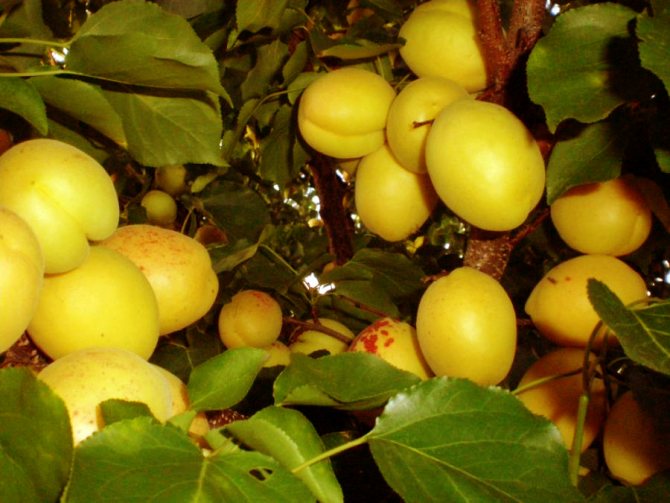
Shalah apricot fruits, when ripe, become very light, almost white
The most common Pineapple - Shalah. His tree reaches a height of 5 m, branches are spreading, foliage is dense. The bark is gray, with longitudinal cracks. The variety is self-fertile, does not require the proximity of other apricots for pollination. After planting, the first fruits can be tasted after 3-4 years.
The fruits are large. They resemble a lemon in shape, with a deep groove that divides the fruit into halves. They weigh 50–80 g. Some reach 120 g. The skin is light cream in color with bright specks on the fruits, most illuminated by the sun. The pulp is the same color as the skin. The variety got its name for its taste and smell, reminiscent of pineapple, but much sweeter. It differs from other varieties by its extraordinary juiciness, which gives a special taste to the fruits, but drying such apricots is problematic. Pineapple's bone is special, narrow, lanceolate. It comes off easily. The kernel has a sweet taste.
The frost resistance is average, although there are reviews from gardeners about the safety and fruiting of trees after the transferred -25-27оС for a long time. Pineapple trees (Shalah) are resistant to moniliosis and perforated spot (coccomycosis).
There is a tendency to damp out the root collar and cambium with improper planting.


The fruits of the Shalakh variety are light, large and unusually tasty.
Pros and cons of the Pineapple variety (Shalakh)
| pros | Minuses |
| Wonderful taste | Short-term preservation of ripe fruits |
| Annual abundant fruiting | |
| Disease immunity | |
| Relative winter hardiness | |
| Self-fertility | |
| Beginning of fruiting 3-4 years after planting |
Apricot Pineapple - video
Several related varieties have been bred from Pineapple seeds by free pollination. The best varieties were Pineapple Tsyurupinsky and Pineapple columnar.
Pineapple Tsyurupinsky: It differs from Pineapple Shalakh in fruits that are smaller and rounder. Weighing about 40-50 g, ripen later, at the end of July. The apricots are light yellow with a bright blush. Light orange pulp, tender, juicy. Fruit tasting score - 4.5 points. The stone is small, with a sweet core, it separates well. Flower buds are more winter-hardy than those of Shalah. It is resistant to diseases, like the mother variety.
Pineapple Columnar: The tree can be grown in a greenhouse. Fruit buds form right on the trunk. Little widespread.
Varieties of apricot Pineapple - photo gallery
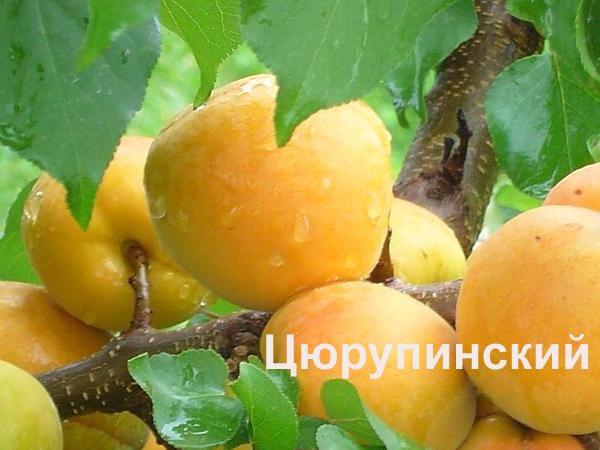

Pineapple Tsyurupinsky - a fruitful and winter-hardy variety
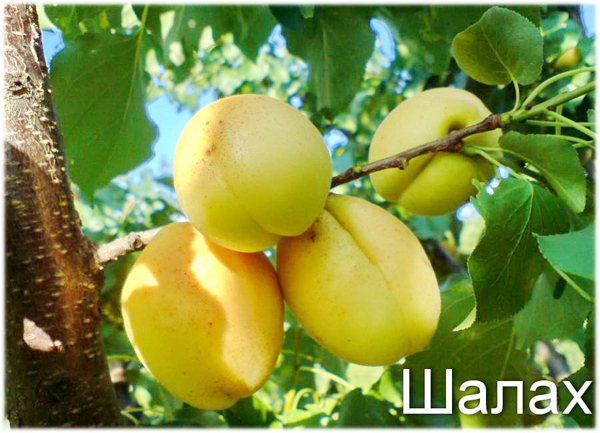

The ancient variety Shalakh is in constant demand among buyers
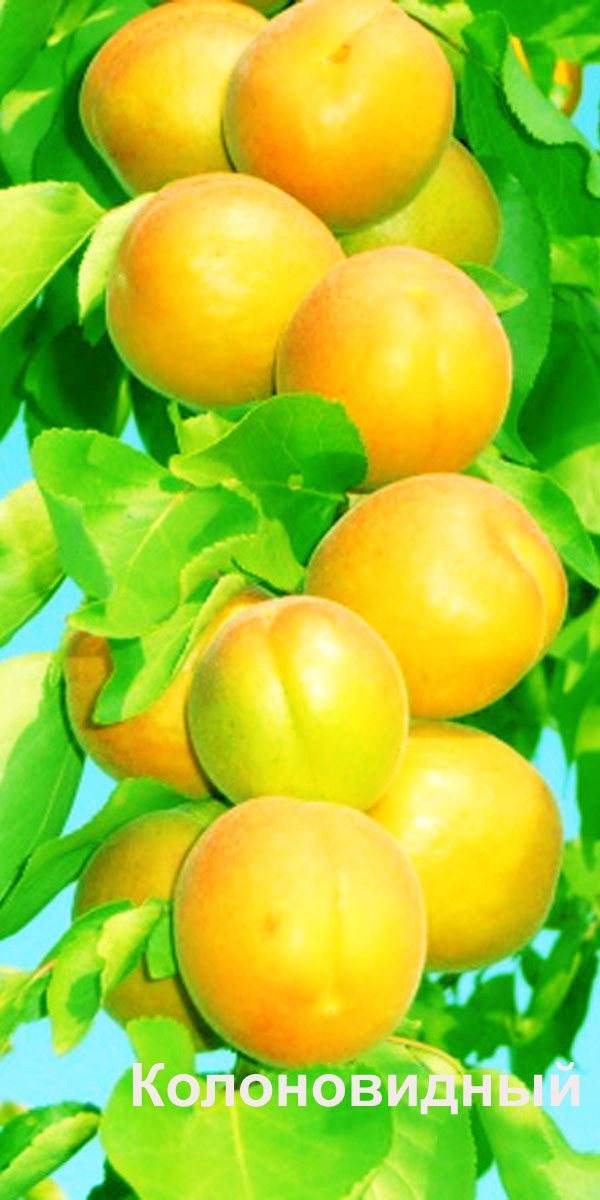

Apricot Pineapple columnar grown in a container, can bear fruit in a greenhouse
Characteristic
Apricot variety Shalakh has its own characteristics:
- fruit crop has a good dense crown, fast growth;
- from the moment of 4 years of age, it begins to bear fruit every year;
- the trunk can grow up to 5 meters in height.
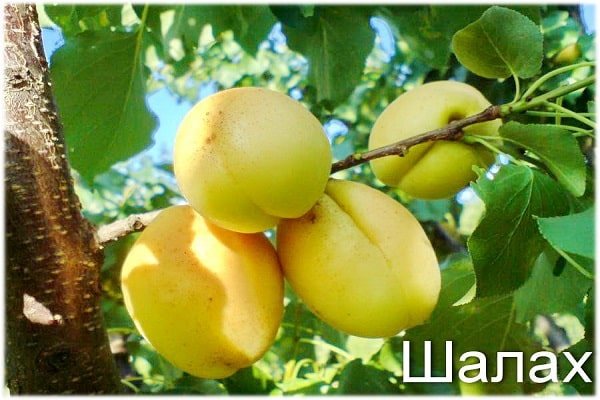

Bloom
Typically:
- the flowering time of a plant depends on the growing climate - in warm regions it comes earlier than in cold ones;
- the flowers are large, up to 3 centimeters in size, with curved white petals, slightly pink on the inside;
- up to 4 years old, it is recommended to pick off flowers so that the apricot gets stronger and can bring a good harvest.
Fruit
Characteristics of the fetus:
- fruits are large (can reach up to 85-90 grams), oval or ellipsoidal, with slight tuberosity;
- color - from pink-yellow to pale fawn, with a delicate blurry, pale crimson, tan;
- the skin is velvety, dense;
- pulp of medium density, juicy, creamy;
- by sugar content - average sweetness;
- has excellent taste;
- the orange-colored bone is easily separated from the pulp, it is small in size;
- the fruit is well preserved during transportation;
- can be eaten fresh, dried, canned, added to baked goods and salads.
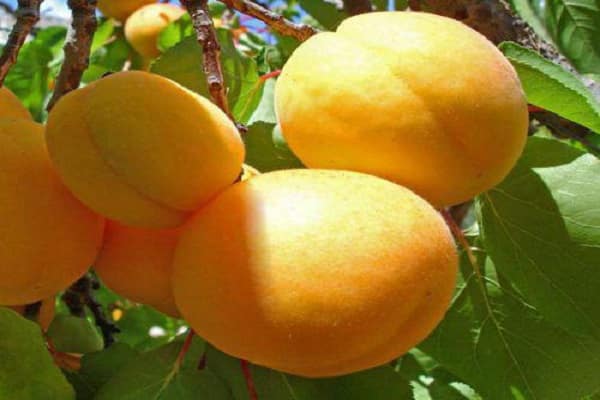

Ripening period
Apricots Pineapple ripens by early July. But the exact time depends on the weather conditions. In the southern regions of Russia, fruits begin to ripen from the beginning of June. In the central regions - in late July or early August.
See also
Growing, planting and caring for apricots in the Moscow region in the open field and pruningRead
Fruit picking
Harvested in warm, dry weather, no more than 7 days.
Due to the peculiarity of light shedding on the ground and bruising when falling, it is better to pick the apricot by hand. And don't shake the branches.
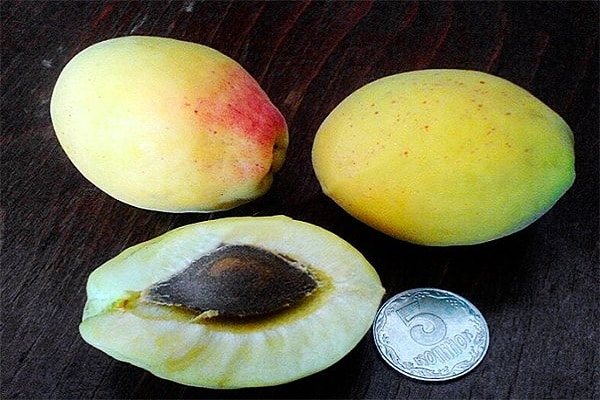

Storage features
Fruits are neatly placed in boxes (wooden, cardboard). Store at low temperatures in special rooms. Crushed fruits cannot be stored. They need to be recycled.
Important! For better preservation, fruits are harvested before ripening, shifting with paper or napkins.
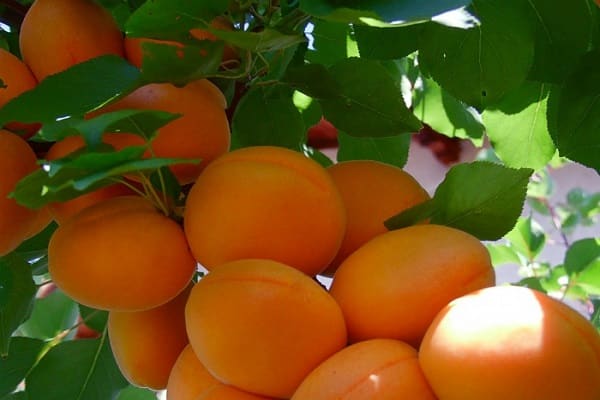

Features of planting apricot Pineapple (Shalah)
Planting an apricot tree of the Pineapple variety (Shalakh) begins with the selection of seedlings. You need to buy them in proven nurseries from well-known gardeners in order to avoid misgrading.
Best of all, one-year or two-year seedlings with rudiments of skeletal branches and good roots take root.
To make sure that the seedling is varietal and not a seedling, you need to find a grafting site. It should be well formed, without protruding spines or ulcerations.
Seedlings can be distinguished by several characteristics: there is no thickening at the site of the intended grafting, there are many side shoots, they are thin. Leaves are rough, shoots with thorns. Dark pink roots with a long central shaft.
Apricot trees of the Pineapple variety with high soil moisture can suffer from bark podoprevanie at the root collar, therefore, if possible, it is better to purchase seedlings grafted at a height of about 1.5 m into the trunk of winter-hardy varieties.
Shalakh, like other stone fruit crops, is best planted in early spring, in April, before the buds swell.
Do not plant apricots in areas with a high groundwater level above 150 cm. The place for the seedling is chosen sunny, without shading by other trees, retreating from them 3-4 meters, on an elevation, in order to avoid the cold air flowing into the lowlands. Small slopes are suitable, but trees feel best at the walls of buildings on the south side. The main condition is good lighting in the first half of the day.Apricot Pineapple (Shalakh) is self-fertile; it does not need trees of other varieties for fruiting.


In a place protected from the winds, the apricot seedling develops quickly and does not get sick
Preparing the soil and planting an apricot seedling in the ground
The seedling pit is prepared in advance: from autumn, as a last resort, two weeks before planting:
- Digging a hole 70 x 70 cm.
- The fertile soil of the upper layer is collected in a separate heap or immediately into buckets.
- A third of the pit is filled with organic debris: fallen leaves, hay, rotten sawdust, etc.
- A mixture is prepared from humus (compost), removed fertile soil and nutritional supplements (ash of deciduous trees - 1 kg, bone or blood meal -300 g)
- The hole is filled to the brim and watered abundantly to settle the soil.
A seedling with an open root system before planting is kept in water for 6-12 hours with root growth stimulants (Kornevin, Zircon, Succinic acid, etc.). Before planting, cut off the broken and blackened roots to a light tissue.
- Make a hole in the planting hole for the roots.
- A stake is driven into the center to tie a tree.
- A seedling is placed vertically to the north of the peg so that the place where the roots begin (root collar) protrudes 5–6 cm above the ground.
- Gradually sprinkle the roots with soil, shaking slightly so that the earth covers them tightly.
- Water abundantly, making sure that the root collar does not get wet. To do this, a roller is made around the perimeter of the pit, and the irrigation hole is formed with an elevation at the stem.
- Tie the trunk of the seedling to the peg with a soft rope or twine.
- The branches of the seedling are shortened by 1/3 of the length.
- The soil of the trunk circle is covered with a layer of organic matter: husk of nuts or seeds, wood chips, sawdust.
Planting a seedling with a closed root system is carried out in the same manner. The only difference is that such plants can be planted at any time during the growing season.
Planting an apricot seedling - video
Selection of seedlings and planting
An important point when growing any tree is the choice of planting material. Planting Pineapple apricot is no exception. It is advisable to purchase a one-year seedling 60–70 cm high, which already has 2–3 branches. The bark of the tree should not have wounds, cracks or any other damage. The root system is branched and fibrous with 2-3 taproots. The presence of thorns on the trunk indicates the semi-wild origin of the plant - it is better to refuse this. The safest way to get a tree is from a nearby nursery: it will be more adapted to local conditions.
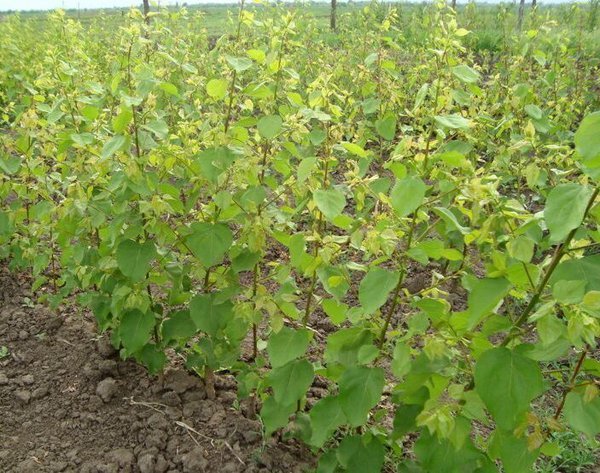

It is better to buy seedlings in the nursery.
Planting apricots is recommended in the spring. Over the summer, the seedling will get stronger and will be able to successfully endure the cold.
Seat selection
Apricot Pineapple is a light and heat-loving plant, so when choosing a planting site, you need to take into account that shading will negatively affect its growth. It does not tolerate an apricot of excessive moisture - it should not be planted in a lowland, a small hill will be much better (the variety does not suffer from the wind). He is not picky about the composition of the soil. Of course, chernozems or loams would be the best option, but this is not of fundamental importance, the main thing is that there is no increased acidity.
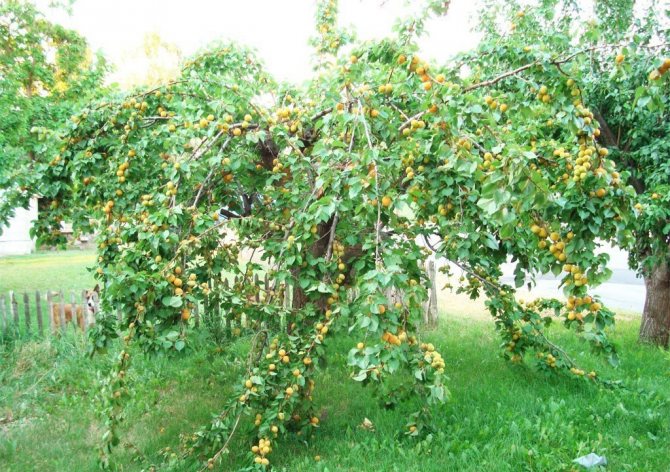

The apricot needs to be planted in a bright, elevated place.
Planting an apricot
The landing pit is prepared in the fall. Its size depends on the size of the root system, but you need to focus on the diameter and depth of 0.7 m.Pour two buckets of any organic fertilizers into the hole and leave until spring for the soil to shrink. If the soil is too dense, then a bucket of coarse sand can be added to the organic matter.


The pit is prepared in the fall
Before planting, which is carried out before the start of sap flow, once again you need to inspect the roots, remove the damaged ones. If they have dried out a little, then put the seedling in a solution of some root-forming agent for 2 hours (this will improve survival rate).
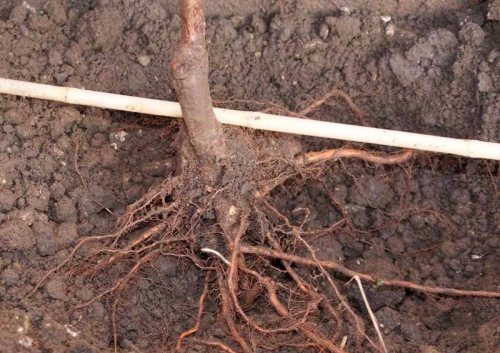

The root collar must be above the soil level
When landing, you should follow a simple sequence.
- Pour 0.3 kg of superphosphate, 0.1 kg of potassium sulfate and 1 kg of lime or dolomite flour into the prepared pit, mix with organic matter (on poor soils, add another 0.1–0.2 kg of urea).
- Drive in a peg to support the seedling.
- Set the plant, straighten the roots and fill the hole halfway with earth (make sure that the grafting site is 5-10 cm above the soil level), compact it a little with your palm.
- Pour out a bucket of water.
- Top up the soil to the desired level.
- Pour out the second bucket of water.
Plant care
In order for a tree to develop quickly and give a crop, it must be properly formed, fed, protected from pests, winter cold and the sun. It is best to mulch the soil under the tree with small chips, sawdust, husks of nuts, seeds, and any other organic matter. Moisture is retained under the mulch, and the soil remains loose. Flowers can be planted along the perimeter of the apricot trunk circle: nasturtiums, marigolds.
Apricot Pruning Pineapple (Shalah)
Without proper pruning, Pineapple apricots will not yield good yields. It is necessary to constantly monitor the size of the crown, the ratio of the branches. With the annual shortening of shoots by 1/3, many fruit buds appear along the entire length of the branch, more leaves are formed. The root system also depends on pruning. With the correct shortening of the shoots, the roots develop better. The suction roots are especially activated, more fibrous ones are formed.
A feature of apricot tree care is summer pruning. It is used to form more winter-hardy buds on shortened branches that do not awaken during winter thaws, which are most dangerous for the tree.
The crown of an apricot is often formed in the form of a bowl, removing the central conductor, and the branches are shortened by 1/3 of the length. As a rule, after removal of the central conductor, lateral shoots are activated. Of these, 3-4 of the strongest are chosen, and the rest are removed. 3-4 shoots are also left on the remaining branches, and the rest are cut out. A free form with a central conductor is also allowed, provided that the crown is sparse.


If you prune the apricot according to the scheme, the tree will be able to give maximum yields.
Sanitary pruning is essential for tree health. It is held in the spring, when the buds open and the damage caused by frost and snow is visible. All damaged branches are removed, cuts and wounds are treated with copper sulfate or ordinary greenery and covered with garden varnish. Do not grind slices, hemp, untreated cracks.
Spring formative pruning of apricot trees - video
How to feed pineapple apricot trees
An excess of nitrogen in the soil is contraindicated for apricot trees. If this factor is not taken into account, the tree begins to have problems with bark and cambium, which are easily damaged even in mild winters. The places where branches leave the trunk and the trunk itself in its middle part are especially affected. If nitrogen is low, the crust becomes too sensitive to sunlight.
Before the start of fruiting, you should not feed the tree with nitrogen fertilizers, since you can cause an active wave of shoot growth, which will negatively affect winter hardiness.
Fruiting apricot trees require regular feeding. At the summer cottage, you can do without chemical fertilizers, and use bone meal to enrich the soil with phosphorus and calcium (up to 200 g under a tree in a tree trunk in the fall). To meet the need for potassium and other trace elements - deciduous tree ash (up to 500 g under a tree in spring). Humus or compost for apricot trees is applied once every 2-3 years (1 bucket for autumn digging in the trunk circle).
It is useful to mulch the near-trunk circle under the cut grass.Gradually decomposing, such mulch fertilizes the soil without exceeding the nitrogen norm for the tree.
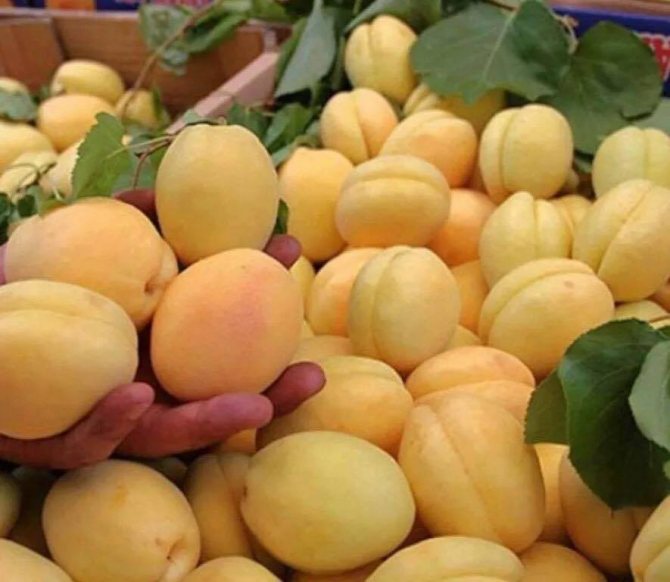

Properly fed and watered Pineapple apricot trees (Shalakh) give a consistently high yield every year
Watering apricot trees
Young seedlings should be watered at intervals of 2-3 weeks (20 liters per plant). Drip irrigation helps to maintain a constant moderate soil moisture in the root zone. Watering is stopped from the second half of August. In dry autumn, after leaf fall, before the onset of stable cold weather, it is necessary to carry out water-charging irrigation - 30 liters per tree.
Apricot trees are the most resistant to drought and dry air. Therefore, they grow best in the south or in the mountains.
Protection of apricot trees from adverse natural factors
In order for the Pineapple apricot to please with crops for many years and not get sick, mechanical damage to the bark, as well as cracks from frost cracks, should be avoided. Apricot bark is especially loved by rodents, so you also need to protect yourself from them in a timely manner using various designs and poisoned baits.
It is not recommended to whitewash young trees under the age of five. To protect them, the barrel is wrapped with various materials that allow air to pass through. The skeletal branches at the bottom are also wrapped. On top of the strapping material from rodents, spruce branches are attached with needles down.
After the tree reaches 5 years of age, in the fall, its bole is covered with whitewash - either a composition of slaked lime with the addition of copper sulphate, or other paints for these purposes, which can be purchased at garden centers.
Winter protection of apricot Pineapple - photo gallery
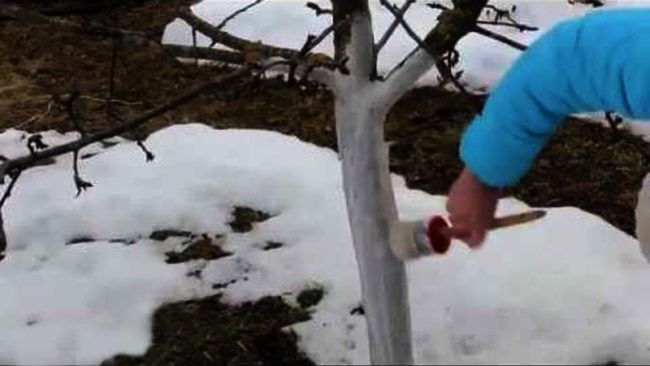

The bark of trees older than five years is covered with whitewash for the winter, which protects the trunks from frost breaks
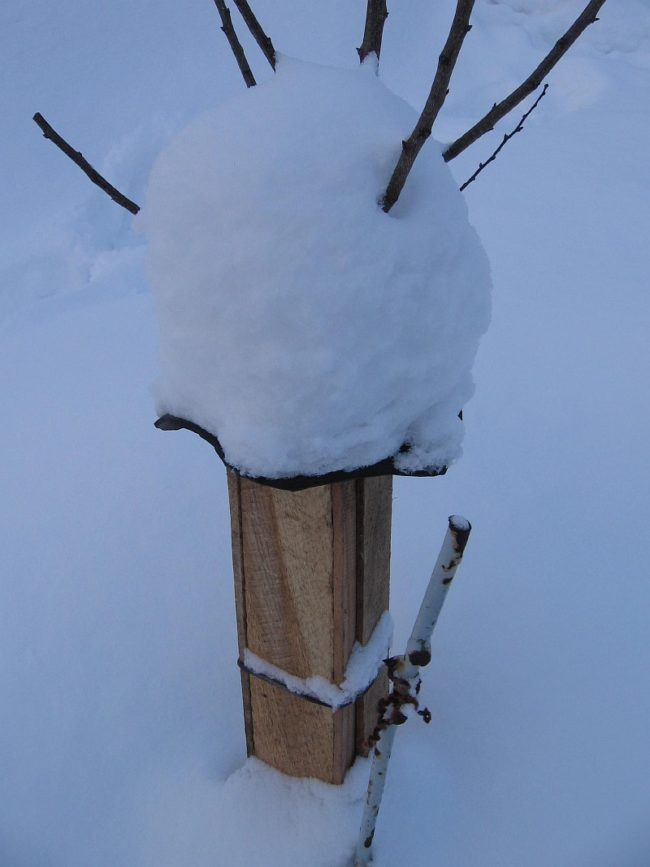

The protective structure will protect the young seedling from all winter threats
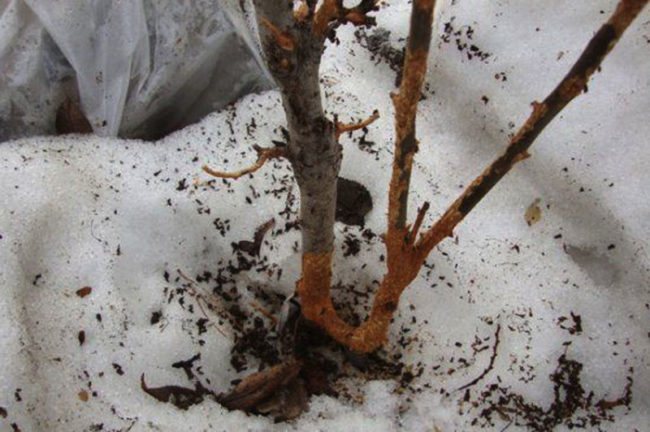

The bark of an unprotected apricot tree is a treat for rodents


Paper strips can be used to protect the barrel
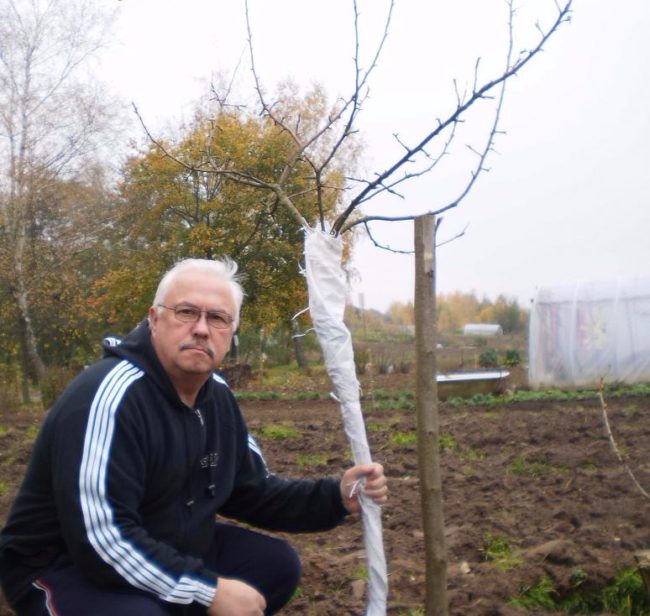

Wrapped in light-colored material, the trunk of the apricot will not be affected by bright sunlight in February
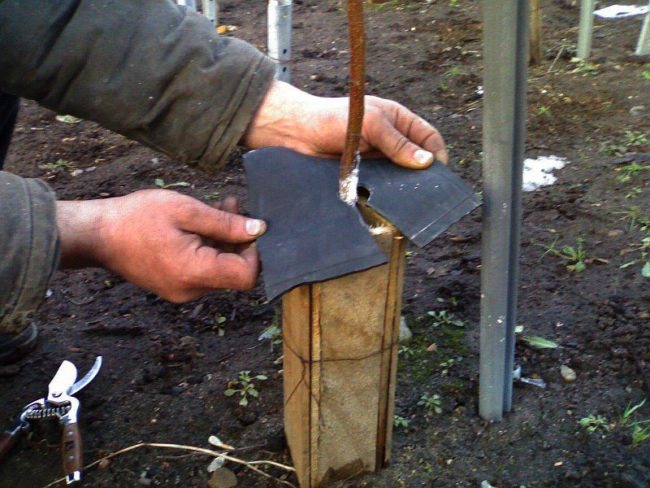

To protect the root collar from drying out for the winter, a structure is built that prevents moisture from penetrating to the lower part of the trunk
Preventive work with apricot trees in spring
After the snow melts, all shelters are removed from the trees. To prevent diseases, the apricot tree is sprayed with 3% Bordeaux liquid. After flowering and the appearance of leaves, spraying is repeated, but already with a 1% solution. The trunk circle is loosened, the mulch is renewed.
Watering
The planted seedling is tied to a support and watered abundantly. This will require at least 2.5 buckets of water. Water should flow exclusively into the groove, but not into the center of the mound.
In the future, apricot seedlings are watered once a week according to the same scheme as for the first time. This is especially important to do at a time when flowering begins or young shoots are growing, as well as a couple of weeks before harvest (May - June). With the arrival of July, watering is stopped in order not to promote the growth of shoots. And the last time you should give the plant a drink before the frost, in the middle of autumn.


Diseases and pests of apricot Pineapple (Shalah)
For hundreds of years of existence of the Pineapple (Shalakh) variety, no diseases of this variety have been observed in apricots. Therefore, at present, these apricots do not get sick. The only threat to the health of the tree is improper care, which leads to damage to the bark, and as a result, to gum leakage. You can avoid this ailment by timely cleaning everything, even the smallest damage, disinfecting sections and cracks, covering them with garden varnish.
Pests of apricot Pineapple (Shalakh) - table
| Pest | The nature of the defeat | Processing period | Means of struggle | Preventive measures |
| Plum aphid | Destroys young leaves, they shrivel and wilt | After finding the first pests | Treatment with Fitoverm, Bitoxibacillin or similar preparations (according to the instructions) | Autumn and spring digging of the soil of the trunk circle, to prevent the appearance of ant nests under the tree |
| Plum moth | Lays the larvae inside the fetus | During the period of fruit formation | Digging the soil, collecting and destroying affected fruits | |
| Yellow plum sawfly | The larva affects the bone and pulp, damaged fruits do not develop | Before flowering | ||
| Leaf roll | Caterpillars destroy buds and leaves | Before flowering and after harvest | Whitewashing with the obligatory addition of copper sulphate, installation of trapping belts |
Apricot pests - photo gallery
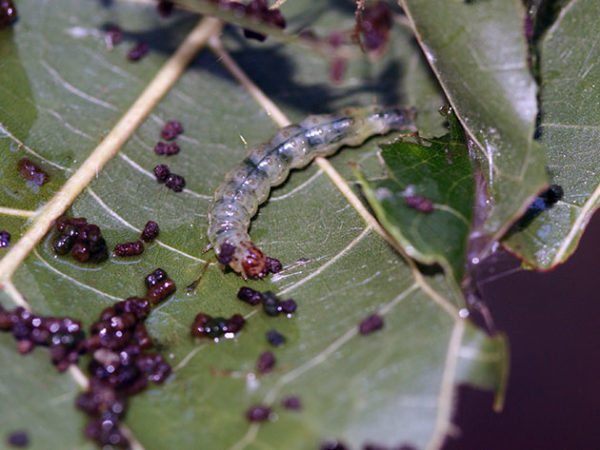

The leafworm damages the buds and leaves
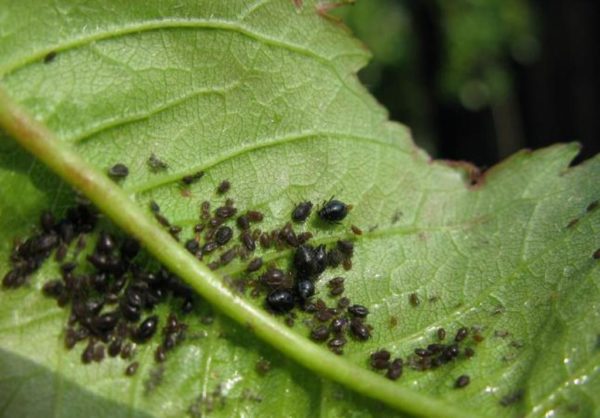

Plum aphid, settles on leaves and young shoots of apricot
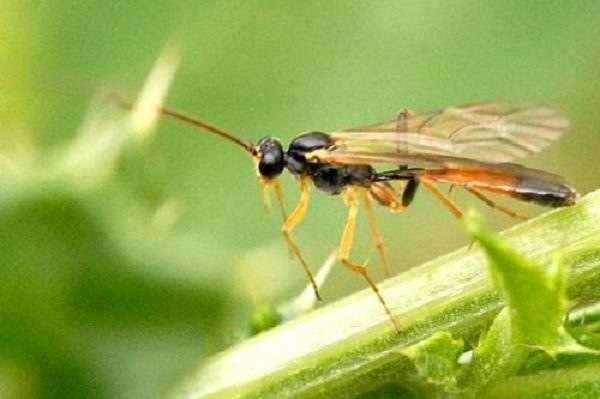

The female plum sawfly lays eggs in the fruit bone
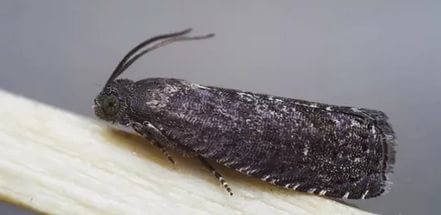

Plum moth butterfly lays eggs in the ovary of the fruit
Reviews of varieties
The advantages of apricot "Pineapple" include increased resistance to damage by leaf curl and the widespread in our country clasterosporiosis. Also, the variety is characterized by sufficient indicators of winter hardiness and drought resistance. Fruit plantations are able to recover as soon as possible after freezing in winter. The relatively late flowering helps to reduce the risk of damage to flower buds by late spring frosts.
Harvesting
Pineapple (Shalah) apricots begin to ripen in mid-July and take about 14 days to harvest. Up to 100 kg of apricots can be removed from one mature tree. If the fruits are intended for transportation, they are removed unripe, greenish. In a refrigerator or basement at a temperature of 0-5 ° C, they can be stored, ripening, up to 1 month. It is impossible to wash the fruit before storing it.
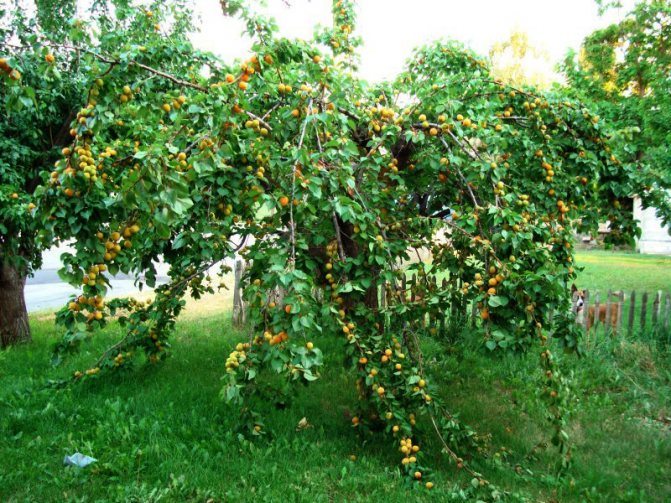

From one adult Pineapple apricot (Shalah), you can collect up to 100 kg of delicious fruits
Ripe apricots do not crumble, but can hang on the branches for some time. Harvested ripe, do not store more than 24 hours at room temperature. They can be stored in the refrigerator for up to three days. It is best to eat apricots of the Pineapple variety (Shalakh) fresh, but the preparations from them are delicious: compotes, preserves, jams.
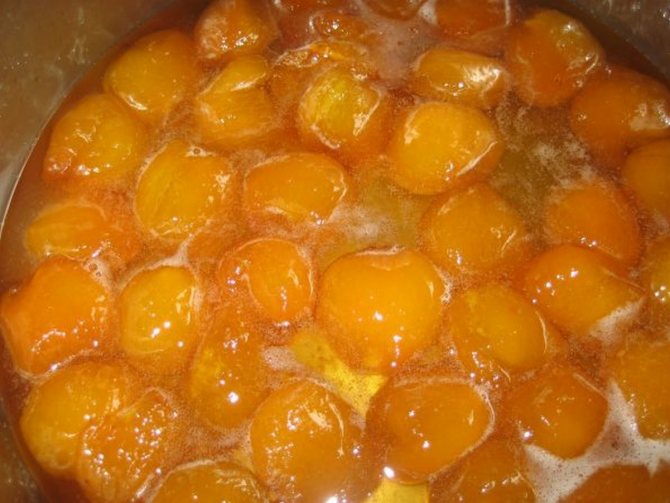

According to gardeners, apricot jam Shalakh is extremely tasty and beautiful
Description of fruits
Pineapple apricot ripens by the middle of July. Ripe apricots have a pale yellow or orange tint. All fruits are the same color. At the same time, there is almost no blush. To the touch, apricots have a pronounced surface roughness with a slight tuberosity.
Oblong large fruits of irregular rounded shape, have a thin, delicate and slightly pubescent skin. On average, their weight reaches 35-45 g. The pulp has a light yellow tint with orange tints. It has a delicate fibrous structure, medium soft. The taste of pineapple apricot resembles the original juicy pineapple fruit with a sweet and sour aftertaste and delicate aroma. All fruits are incredibly juicy and tasty with a huge amount of vitamins.
A distinctive feature of the variety is a small pit with a seed inside, which is easily separated from the surrounding tissues. Eating more than 20 grains is highly undesirable, since they are saturated with chenille acid. In small quantities, it is useful, and in high doses, it is dangerous to health.
You can make jam or jam from pineapple apricot, and it is also suitable for making compote, juice or dessert. But the tastiest thing is to eat fresh, juicy and ripe fruit.
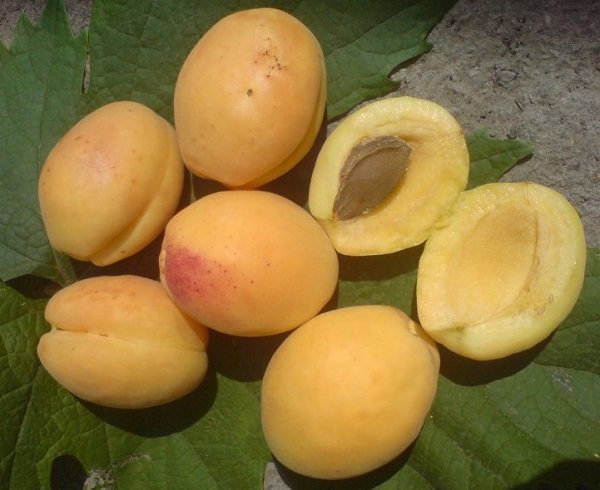

Reviews of gardeners about the apricot Pineapple
She made compote and pineapple jam. I can say that I have never eaten or cooked such apricot blanks before or after.In jam, it is not that the slices are boiled, they have remained one and all, and even, as it were, have become attached. At the same time, the jam was cooked, and not filled with syrup. Compote is also of excellent taste. The fresh apricot did not make much of an impression on the taste, it is so sweet, slightly different - pineapple aroma, but the blanks are just super.
Nnv
Many farmers and simply gardeners grow Pineapple, it is still very popular, yes, it is not frost-resistant, so there are spans with the harvest. The yield is sufficient.
Yuri
Many complain about the relatively low yield, but nevertheless the demand for pineapple seedlings is high.
Beta
As for me, Pineapple is the most delicious ... I've bought Red-cheeked - and Pineapple has grown to my happiness there is no limit.
OH YEAH
Just half an hour ago, a neighbor presented a basin of apricot of the Pineapple variety. To be honest - not impressed. Some kind of liquid.
MArilka
Apricot Pineapple (Shalakh) does not require advertising. Everyone has tasted its amazingly tasty fruits at least once. And if we take into account that trees of this variety do not require complex care, they can withstand frosty winters without reducing productivity, it becomes clear that Pineapple has no worthy competitors.
All her life she worked as the head of the library. I am fond of gardening, horticulture, I love computers and the Internet, I have experience in creating websites manually in HTML, occasionally I blog. Rate the article:
- 5
- 4
- 3
- 2
- 1
(1 vote, average: 4 out of 5)
Share with your friends!
Pros and cons of the variety
According to the description, the benefits of Pineapple apricot outweigh its disadvantages. Self-fertile, early-ripening variety with excellent resistance to some common diseases, drought and frost, which regularly gives a large number of large, tasty, healthy fruits of almost white color, cannot but attract. The fruits of universal use are well transported, which is convenient for those who grow Pineapple apricots for sale.
The disadvantages include shedding of fruits after ripening and a short shelf life. Ripe fruits can be stored at a low temperature for up to 10 days. If you try very hard (collect at the stage of technical maturity, wrap it up separately with paper), then this period can be extended to 3 weeks.
- Those who have practiced the cultivation of Shalakh note the following positive characteristics:
- fairly stable fruiting;
- large fruits;
- good productivity;
- peculiar aroma and taste of apricots;
- good transportability;
- quick recovery of the tree after frost;
- self-fertility;
- tolerance of short-term moisture deficit;
- good frost resistance;
- immunity to many specific diseases.
- Among the disadvantages, gardeners note:
- short storage period for fruits (no more than two weeks);
- predisposition to thickening;
- shedding of fruits in case of overripe.

